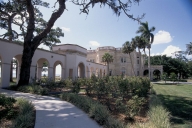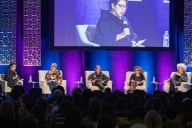You have /5 articles left.
Sign up for a free account or log in.
Stickers proclaiming "Women Also Know Stuff" were distributed last week at the annual meeting of the American Political Science Association.
A group by that name created a website this year listing more than 1,000 female scholars in political science, organized by areas of expertise and with links to the scholars' websites, email addresses and more. The expertise areas are detailed, making it difficult for anyone to say that they can't think of any women who study, for example, political economy or international law or the politics of crime, among many other categories.
The frustrations about all-male or largely male panels extend to many disciplines. Regularly, when women raise concerns that talent from female scholars is being overlooked, some respond that women in whatever field just must not be as worthy or must not be applying to appear on panels.
A new study, however, suggests that gender may well have an impact on how proposals to present at conferences are reviewed.
The study -- published in the Journal of Language Evolution -- is based on a change in the way paper proposals were reviewed for the Evolution of Language Conference, which takes place every two years and is a premier academic event for those in the field. For the most recent conference, held this year, the organizers switched from a single-blind review to a double-blind review.
In single-blind review, the names of reviewers are not disclosed to those who have made submissions. The idea is that reviewers need not fear offending anyone with frank comments. But the reviewers know who has submitted. In double-blind review, all names are shielded, so that reviewers' identities are protected, but they don't know the identities of those who are being judged.
When the language conference switched to double blind this year, the rankings of paper proposals from women or teams where a woman was the first author saw a gain of 4 percent on the ratings system. The ratings of proposals by men or where a man was the first author saw a 19 percent decline in their ratings.
Further, the study found a gender impact when looking at women and men who had submitted papers under single-blind review to prior conferences and to the most recent conference under double-blind review. Under double blind, the women-authored papers moved up and the men-authored papers moved down in the rankings.
Women in some disciplines are pushing to publicize the gender breakdowns on panels as a way of drawing attention to whatever causes result in a disproportionate number of slots going to men.
BiasWatchNeuro is a website that tracks gender breakdowns on panels in neuroscience.
The website does not assume that women are 50 percent of available scholars for a given conference. But it posts reports on the gender breakdown, along with estimates on the percentage of women in the field. In the summaries of recent conferences, there are some conferences where the share of women exceeds the percentage of women in the field, and others not. In some cases, the reports note where there are different ratios for all presentations and for plenary addresses, with the latter in some cases more dominated by men than are the total speaking invitations.
The organizers of BiasWatchNeuro offer this explanation on their site: "Conference panels that are diverse with respect to gender, race, ethnicity and national origin help advance this goal. Homogenous conference programs are generally not representing their field, missing out on important scientific findings, and are one important factor contributing to the brain drain of talented female and minority scientists from the scientific workforce."








